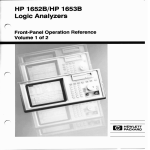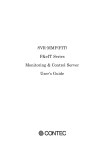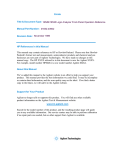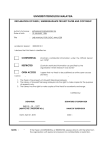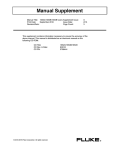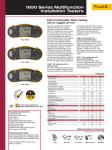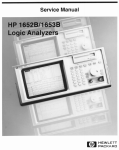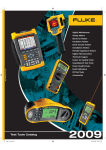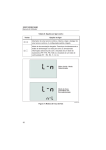Download Getting Started - HP 1652b Logic Analyzer Manuals and Disks
Transcript
-
Getting Started Guide
HP 1652B/HP 1653B
Logic Analyzers
HEWLETT
PACKARD
@Copyright Hewlett-Packard Company 1990
Manual Set Part Number 5952-0176
Printed in the U.S.A. January 1990
Introduction
-
About this
book...
Welcome to Hewlett-Packard logic analyzers. The HP 1652B and
HP 1653B Logic Analyzers are more than just another logic analyzer.
They are an analyzer and oscilloscope in one instrument. With this
combination, you have expanded measurement capabilities.
The user interface of the HP 1652B/HP 1653B was designed to be as
easy to operate as possible. The use of “pop up” windows help lead you
through setups and measurements without having to memorize a lot of
steps. As you read this guide and the other references about the logic
analyzer, you will see just how easy to use the HP 1652B/HP 1653B
really is.
We will not cover every feature and function of the HP 1652B/HP
1653B Logic Analyzer in this guide. The purpose of this Getting Started
Guide, is to get you going quickly, by giving you the basic user interface
information along with a couple measurement examples. The detailed
information will be found in the HP 1652B/HP 1653B Front-Panel
Operation Reference.
-
If you are new to logic analyzers and digitizing oscilloscopes, or just
need a refresher, we think you will find Feeling Comfortable With Logic
Analyzers and Feeling Comfortable with Dig&king Oscilloscopes
valuable reading. These books will help eliminate any misconceptions
or confusion you may have about the analyzer’s applications, and will
show you how to get the most out of it’s measurement functions.
How to use
this guide
This guide is organized into two types of information. The first three
chapters cover basic user interface information. If you are an
experienced HP logic analyzer user, but new to this family of logic
analyzers, you may want to read just the first three chapters and then
go directly to the HP 1652BIHP 1653B Front-Panel Operation
Reference.
The next three chapters simulate basic measurementsin a
task-oriented format. These example measurements,illustrate menu
setup, in a step by step order commonly followed when solving digital
systemproblems. If you are new to HP logic analyzersand logic
analysis,you should include the measurementexamplesas part of your
reading.
You will seeillustrations of menu setupsinterspersed with text. If you
are going through a sequencefor the first time, you should refer to the
illustrations while reading the text, to aid your understanding. If you
are a fast learner and remember the first three chapters on the user
interface, you can follow through the examplesby just referring to the
illustrations.
Contents
-
Chapter 1:
Introducing the HP1652B/HP 16538
l-l
What Are the HP 1652B and HP 1653B? ........................
l-2
Getting Ready to Operate ....................................
l-2
Initial Inspection ............................................
..l- 3
Accessories ..............................................
l-3
Removing Yellow Shipping Disk ...............................
l-4
Selecting the Line Voltage ....................................
l-5
Checking for the Correct Fuse .................................
l-5
Connecting the Power Cable ..................................
Operating Environment and Ventilation . . . . . . . . . . . . . . . . . . . . . . . . l-6
. l-6
Loading the Operating System ................................
l-7
Installing the Operating System Disk ...........................
..l- 8
LineSwitch.. .............................................
l-9
Power-up Self-Test ..........................................
l-10
Adjusting the Display Intensity ...............................
Summary..................................................l-lO
Chapter 2:
Getting to Know the Front Panel
Introduction ...............................................
Front Panel Organization ....................................
Display.. ..............................................
Cursor ................................................
MenuKeys...............................................2DiskDrive .............................................
RollKeys ..............................................
Knob....................................................2Inputs .................................................
Keypad.. ..............................................
Summary...................................................2-
-_
HP 1652B/1653B
Getting Started Guide
.2-l
.2-l
..2- 2
..2- 2
2
..2- 3
..2- 3
3
..2- 3
..2- 4
4
Contents - 1
Chapter 3:
Chapter 4:
Chapter 5:
Contents - 2
Gettin to Know the Main Menus
Introduction ...............................................
Exploring the System Configuration Menu .....................
Using the Cursor, Knob and SELECT Key ..................
Configuring the Analyzer ..................................
Pod Assignments ........................................
Autoscale................................................3Moving Around the Main Menus .............................
Accessing the Main Menus ................................
TRACE/TRIG.........................................3DISPLAY.............................................3Returning to the System Configuration Menu ...................
Summary...................................................3-
Using the State Analyzer
Introduction ...............................................
Problem Solving with the State Analyzer .......................
What Am I Going to Measure? ...............................
How Do I Configure the Logic Analyzer? ......................
Connecting the Probes ......................................
Activity Indicators .......................................
Configuring the State Analyzer ...............................
SpecifyingtheJClock..
....................................
Specifying a Trigger Condition ..............................
Acquiring the Data ........................................
TheStateListing
.........................................
Finding the Answer ........................................
Summary..................................................4-16
Using the Timing Analyzer
Introduction ..............................................
Problem Solving with the Timing Analyzer .....................
What Am I Going to Measure? ...............................
How Do I Configure the Logic Analyzer? ......................
Connecting the Probes ......................................
Activity Indicators .......................................
Configuring the Timing Analyzer .............................
.3-l
.3-l
.3-2
.3-2
.3-3
4
.3-5
.3-5
6
6
.3-7
8
.4-l
.4-2
.4-2
.4-4
.4-6
.4-6
.4-7
..4- 9
.4-10
.4-12
..4-13
.4-14
.5-l
.5-2
.5-2
.5-3
.5-5
.5-5
.5-6
HP 16528/l 6538
Getting Started Guide
--
-.
-.
Chapter 6:
-
Specifying a Trigger Condition ..............................
Acquiring the Data ........................................
The Timing Waveforms Menu ...............................
TheXandO
..........................................
Thev
...............................................
The Vertical Dotted Line ................................
Configuring the Display ....................................
Display Resolution ......................................
Making the Measurement ...................................
Finding the Answer ........................................
Summary..................................................5-15
Using the Oscilloscope
Introduction ..............................................
Getting to the Scope Menus .................................
Setting Up for the Measurement ..............................
Making the Measurement ....................................
Displaying the Results .......................................
Automatic Measurement Readouts ...........................
Using the Markers ..........................................
Summary...................................................6-
Chapter 7:
What’s Next?
Appendix A:
Logic Analyzer Turn-on Check List
Appendix B:
Making Hardcopy Prints
Introduction ...............................................
Hooking Up Your Printer ...................................
Setting RS-232C for HP Printers ..............................
Setting RS-232C for Your Non-HP Printer .....................
Setting Hp IB for HP Printers ...............................
Starting the-printout ........................................
PrintScreen .............................................
PrintAll ................................................
What Happens during a Printout? ............................
Summary ..................................................
_-
HP 16528/16538
Getting Started Guide
..5- 8
..5- 9
.5-10
..5-10 t
..5-11
.5-11
.5-12
.5-12
.5-13
.5-14
.6-l
.6-l
.6-2
.6-3
.6-4
.6-5
.6-5
7
B-l
B-l
B-2
B-3
B-4
B-5
B-5
B-6
B-6
B-6
Contents - 3
-
-
Introducing the HPl652B/HP
What Are the
HP 1652B and
HP 1653B?
1653B
1
The HP 1652B and HP 1653B logic analyzers are general-purpose logic
analyzers with built-in oscilloscopes. If you’re familiar with the
HP 1652B/HP 1653B or any HP digitizing oscilloscope, you’ll recognize
many features that you’ve grown to know and love. If you’re new to our
analyzers and oscilloscopes, the HP 1652B/HP 1653B is easy to get to
know.
The only differences between the HP 1653B and the HP 1652B, are the
number of data channels and the speed of the state analyzer. The
HP 1652B has 80 data channels and 35 MHz state analysis while the
HP 1653B has 32 data channels and 25 MHz state analysis. Both
analyzers have 100 MHz timing analysis along with 100 MHz
single-shot and repetitive (repetitive single-shot) oscilloscope
measurement capabilities. Because the differences are small between
both instruments, they use the same set of manuals.
-
Some of the key features shared by both the HP 1652B and HP 1653B
are listed below:
Transitional or glitch timing mode on all channels.
Simultaneous state/state or state/timing modes.
Glitch detection on all channels.
Marker measurements.
Timing and Scope Autoscale.
Scope Automeasure.
Pattern, edge, and glitch triggering.
Overlapping of waveforms.
Small lightweight probing.
Time and number of states tagging.
State Compare, Waveform, and Chart.
This Getting Started Guide covers only a few of the logic analyzer’s
features. You will find details of all the features of the HP 1652B and
HP 1653B in the HP 1652BJHP 1653B Front-Panel Operation Reference
Manual.
-
HP 1652B/16538
Getting Started Guide
Introducing. the HP 1652B/HP 16538
l-l
Getting Ready
to Operate
If you havejust unpacked your new HP 1652B/1653B logic analyzer,
please take a few minutes to completely read this chapter. It tells you
how to prepare your logic analyzerfor applying power and turning it
on. If you are learning how to use the logic analyzer and it is already
turned on, start with chapter 2, “Getting to Know the Front Panel”.
Initial
Inspection
Inspect the shipping container for damage. If the shipping container or
packaging materials are damaged,you should keep them until the
contents of the shipment have been checked for completenessand the
instrument has been checked mechanically and electrically.
If there is damageto the instrument, refer to the servicemanual for the
proper procedure for contacting the nearest servicecenter.
Introducing the HP 1652B/HP 16538
1-2
HP 16528/1653B
Getting Started Guide
Accessories
In addition to checking the instrument for damage, you should also
check to see that the accessories supplied with it are complete.
. The HP 1652BJHP 1653B Front-Panel Operation Reference Manual lists
all the accessories shipped with the HP 1652B/HP1653B logic
analyzers. If any of these items are missing contact your nearest
Hewlett-Packard Sales Office.
Removing
Yellow
Shipping Disk
-.
Your logic analyzer is shipped with a protective yellow shipping disk in
the disk drive. Before you can insert the operating system disk you must
remove the yellow shipping disk.
Slide the white locking tab to the right and press the disk ejection
button as shown in the following figure. The yellow shipping disk will
pop out part way so you can pull it out of the disk drive.
-
-
-
00
00
00
Cl0
00
ICI
-
-
01652E06
HP 1652B/16538
Getting Started Guide
introducing the HP 1652B/HP 16538
1-3
Selecting the
Line Voltage
The line voltage selector has been set at the factory to the line voltage
used in your country. It is a good idea to check the setting of the line
voltage selector so you can become familiar with what it looks like. If
the setting needs to be changed, follow the procedure in the next
paragraph.
---
You can damage the logic analyzer if the fuse module is not set to the
correct position.
-
01650E02
You change the line voltage setting by pulling the fuse module out and
re-inserting it with the proper arrows aligned. To remove the fuse
module, carefully pry at the top center of the module, as shown in the
figure above, until you can grasp it and pull it out by hand.
Introducing the HP 1652B/HP 16538
I-4
HP 16528/16538
Getting Started Guide
-
-
Checking for
the Correct
Fuse
If you need to check for the correct fuses, remove the fuse module and
look at the amperage and voltage of each fuse. The following figure will
help you locate the 115 V and 230 V fuses. To remove the fuse module,
carefully pry at the top center of the module until you can grasp it and
pull it out by hand. (Refer to, “Selecting the Line Voltage” on the
previous page.)
01650E03
3.0
Connecting the
Power Cable
Warning
A FUSE
3.0
A FUSE
The HP 1652B/HP 1653B comes with a 3-wire power cable. When you
connect the cable to an appropriate AC power receptacle, a ground is
provided for the instrument cabinet. The type of power cable you
receive with the instrument depends on your country. Refer to
appendix D of the HP 1652BIHP 1653B Front-Panel Operation
Reference manual for power cord types.
To avoid possible shock hazard, you must connect the
instrument to a properly grounded 3-wire receptacle.
-
HP 16528/1653B
Getting Started Guide
Introducing the HP 1652B/HP 16538
I-5
Operating
Fnwivnnmnnt
-
and Ventilation
Loading the
Operating
System
You may operate your logic analyzer in a normal lab or office
environment, but don’t block its ventilation. You must provide an
unrestricted airflow for the fan and ventilation openings in the rear of
the logic analyzer. However, you may stack the logic analyzer under,
over, or in-between other instruments as long as the surfaces of the
other instruments aren’t needed for their ventilation. If you intend to
use it in another type of environment, refer to Appendix F in the
HP 1652BlHP 1653B Front-Panel Operation Reference Manual.
Before you can operate the logic analyzer, it must transfer its operating
system from disk memory to its internal memory. This is called “loading
the operating system” or “booting.”
The logic analyzer operating system is a set of instructions that control
the operation of the instrument. The operating system resides on a
3.5inch flexible disk. You received two identical operating system
disks. You should mark one of them Master and store it in a safe place.
Mark the other one Work and use only the work copy. This will provide
you with a back-up in case your work copy becomes corrupt.
To prevent damage to your operating system disk, DO NOT remove
the disk from the disk drive while it is running. Remove it only after the
indicator light has gone out.
Introducing the HP 1652B/HP 1653B
1-6
HP 16528/1653B
Getting Started Guide
-
-
Installing the
Operating
System Disk
To load the logic analyzer’soperating system,you must install the disk
as shown below before you turn on the power. When the disk snapsinto
place, the disk eject button will pop out.
-
0 1650E07
HP 16528/1653B
Getting Started Guide
Introducing the HP 1652B/HP 1653B
1-7
Line Switch
The line switch is on the rear panel. You turn on the logic analyzer by
pressing the "1“ on the rocker switch. Make sure the operating system
disk is in the disk drive before you turn it on. If you forget the disk,
don’t worry, you won’t harm anything. You will merely have to repeat
the turn-on procedure with the disk in the drive.
0165OEO5
Introducing
1-8
the HP 1652B/HP
16538
HP 16528/16536
Getting Started Guide
Power-up
Self-Test
When you turn on the logic analyzer, it performs a series of self-tests.
When it has successfully completed these tests, it loads the operating
system into memory from the disk.
When the logic analyzer has completely loaded the operating system it
displays the System Configuration menu as shown below.
-
System Conf iguretion
finalyzer
Type:
IO”]
1
Lnalyzer
Type:
2
1-1
----------------
I
Note !b
This is the HP 1652B System Configuration menu. If you have an
HP 1653B, the only difference is pod 1 will be assigned to analyzer 1
and pod 2 will be assigned to analyzer 2. There won’t be any pods in the
Unassigned area of the display.
-
HP 16528/1653B
Getting Started Guide
Introducing the HP 1652B/HP 16538
1-9
Adjusting
Display
Intensity
the
I
Note !b
Summary
Once you have turned on the instrument, you may want to set the
display intensity to a different level that’s more comfortable for you.
You do this by turning the INTENSITY control on the rear panel.
A high intensity level setting may shorten the life of the CRT in your
instrument.
Now that you have unpacked, inspected, and begun operating the logic
analyzer, the next step will depend on your needs. If you are a first-time
logic analyzer user who wanted to get the instrument running before
reading FeeZingComfortable with Logic Analyzers and Feeling
Comfortable with Digitizing OsciZZoscopes, you should read them now.
If you are familiar with logic analysis, read either the rest of this Getting
Started Guide or the HP 1652BIHP 1653B Front-Panel Operation
Reference Manual.
Introducing the HP 1652B/HP 16538
I-IO
HP 16528/1653B
Getting Started Guide
Getting to Know the Front Panel
Introduction
The HP 1652B/HP 1653B logic analyzershave been designed to be very
easyto use.The controls are located logically by function so you can
learn how to use them quickly and easily.
This chapter divides the front panel into these functional areas and
givesyou an overview of each area.
-
Front Panel
Organization
The functional areasof the front panel are the display, disk drive, menu
keys,roll keys,cursor, keypad, knob and input.
DISPLAY
CURSOR
DISK DRIVE
MENU KEYS
1
ROLL KEYS
KNOB
I
KEYPAD
HP 16528/16538
Getting Started Guide
\
INPUTS
Getting to Know the Front Panel
2-1
Display
The display is where the various menu screensappear. Menu screens
show analyzer and oscilloscope configurations as well as measurement
results. Menus have many different functions you can execute. Most
functions are activated by highlighting a field in the menu with the
cursor, and then pressing the SELECT key.
Cursor
The cursor is a movable indicator on the display that allows you to
accessdesired fields in each menu. It changesthe field where it resides
from the normal white background to the dark background (inverse
video). The knob movesthe cursor to the field (function) you wish to
activate.
Menu Keys
The MENU keys allow you to quickly move between the major menus
that are available. What menus are available depends on which part of
the HP 1652Bor HP 1653Byou are currently using.
When the FORMAT/CHAN
l
l
l
key is pressed,the following menus appear:
State Format Specification (if you are in the state analyzer)
Timing Format Specification (if you are in the timing analyzer)
Channel (if you are in the oscilloscope)
When the TRACE/TRIG key is pressed,the following menus appear:
l
l
l
State Trace Specification (if you are in the state analyzer)
Timing Trace Specification (if you are in the timing analyzer)
Trigger (if you are in the oscilloscope)
When the DISPLAY key is pressed,the following menus appear:
o State Listing (if you are in the state analyzer)
Timing Waveforms (if you are in the timing analyzer)
a Waveforms (if you are in the oscilloscope)
l
When the I/O key is pressed,the samemenu appears no matter which
part of the HP 1652Bor HP 1653Byou are using. The I/O menu makes
available all the Input /Output operations.
Getting to Know the Front Panel
2-2
HP 16528/1653B
Getting Started Guide
_--
-
Disk Drive
--
ROII Keys
-
Knob
-
The disk drive is used by the HP 1652B/HP 1653B to load the
operating system every time the logic analyzer is turned on. You will
use the disk drive to load configurations or store configurations,
acquired data, and inverse assemblers for later use. The disk drive uses
3.5inch flexible disks. More information on loading files is found in
Appendix B of this guide. Complete details on the disk drive and its
functions can be found in the HP 1652B/HP 1653B Front-Panel
Operation Reference manual.
When part of the listing or waveforms data is off screen, the ROLL
keys define which way the knob will move the displayed data. You will
use these keys and the knob to roll displayed data up/down or left/right
to view data that is off-screen.
The Knob has four major functions depending on what menu or
pop-up menu you are in. The KNOB allows you to do the following
actions:
l
l
l
-
l
h’lplJtS
-
Move the cursor from field to field within the System
Configuration and main menus.
Roll the display left or right and up or down.
Position the cursor on options within pop-up menus.*,
Increment/decrement numeric values in numeric entry pop-ups.
The HP 1652B and HP 1653B has both front-panel inputs and rear
panel inputs/outputs. The front panel INPUTS 1 and 2 are for signal
input to the oscilloscope. BNC cables or oscilloscope probes can be
used.
Logic analyzer probe inputs, labeled by POD and CLOCK, are located
on the rear-panel. In addition, a Probe Compensation Signal, and
EXTERNAL TRIGGER IN/OUT BNCs are on the rear-panel.
HP 1652B/1653B
Getting Started Guide
Getting to Know the Front Panel
2-3
Keypad
Summary
The keypad has keys for entering data as well as the RUN and STOP
keys (for acquiring waveform data). When entering numeric data, use
the CHS key to changethe sign of the number. When entering
patterns, the DON’T CARE key enters an X (“don’t care”) in place of a
regular digit. PressingCLEAR ENTRY replaces the entry with the
default value.
Now that you are acquainted with the front panel organization, you will
be able to decide where you want to go next. If you are just starting to
learn logic analysis,you should read this entire guide. If you are
experienced in logic analysis,you should continue to read chapter 3 to
become more familiar with the operation of the front panel before you
turn to the reference manual.
Getting to Know the Front Panel
2-4
--
3
Getting to Know the Main Menus
Introduction
This chapter introduces you to the main menus of the HP 1652Band
HP 1653B. The main menus are used to configure the logic analyzer
and display the measurementresults. In this chapter, you will learn
how to move between the different machines (state analyzer,timing
analyzer, and oscilloscope) and how to move between menuswithin
each machine. You will also learn how to quickly get back to the
SystemConfiguration menu from any of the main menus.
In addition to learning the main menus,you will be introduced to some
common pop-up menu types. There is more information on the use of
all the pop-up types in the example exercisesin chapters 4 through 6.
-
y
-
Exploring the
System
Configuration
Menu
The first exercisein this chapter starts from the SystemConfiguration
menu. If you are not in the SystemConfiguration menu as shown
below, turn the power switch off, then back on.
An HP 1652Bis used in this example. If you have an HP 1653B,there
will only be two pods. The following procedure is the samefor both
logic analyzers.
Sys tern Configuration
Unassi
riig
llnelyzer
-Es!?3
-
HP 16528/1653B
Getting Started Guide
Getting to Know the Main Menus
3-1
Using the Cursor,
Knob and
SELECT Key
Most of the logic analyzer operation is initiated by placing the cursor
on the field you want to interact with and pressing the SELECT key.
To move the cursor from field to field, just turn the knob.
Depending on the field type (immediate execute or pop-up) pressing
SELECT will either execute a function or open a pop-up menu.
Configuring the
Analyzer
-
In the following exercise, you will use a selector type pop-up to assign
Analyzer 1 as a state analyzer and Analyzer 2 as a timing analyzer.
You will use the Alpha Entry pop-up to assign unique names to each
analyzer.
1. Select the Type: field of Analyzer 1, then select State from the
selector pop-up.
Notice, once you have assigned Analyzer 1 as State, a new field appears
directly above the Type: field. This new Name: field, is where you will
assign the analyzer’s unique label.
2. Select the Name: field. An Alpha Entry pop-up will appear.
3. Use the knob to place the cursor over the letter you want, then
press the SELECT key. As you repeat this step for all the letters
in the label, the label will be spelled out, left to right, inside the
bracket at the bottom of the pop-up.
-
To make changes or corrections in the Alpha Entry field, place the
under-score marker under the character you want to change.
-
To move the under-score marker to the left, place the cursor over the
left arrow and press SELECT once for each backspace.
To move the under-score marker to the right, you either place the
cursor on a desired character and press SELECT, or place it on the
right arrow and press SELECT.
You can also use the ROLL kevs and the knob to move the underscore
marker.
4. When you are finished spelling out the label, select Done.
5. Repeat steps 1 through 5, assigning Analyzer 2 as Timing.
Getting to Know the Main Menus
3-2
HP 16528/1653B
Getting Started Guide
-7
The figure below is what your SystemConfiguration menu should look
like. For this example,we have labeled Analyzers 1 “MY STATE” and
Analyzer 2 “MY TIMING.”
System Configuration
bnalyzer
1
Lnalyzer
Name: -1
Name: w-1
Type:
Type:
7-j
(-1
(Autoscale
Pod Assignments
2
>
J
Unassi
?
fig
Clnalyzer
Pod labels in the SystemConfiguration menu match the inputs on the
rear panel. Pods are assignedto the analyzer machines as follows.
1. Position the cursor over the Pod you want to assign,as shown
below, then press the SELECT key.
2. When the selection pop-up appears, select the Analyzer you want
the pod assignedto. The pod will automatically move under the
analyzer machine you select.
System Configuration
finalyzer
Type :
El
1
Off
Unassi
rhh:
Analyzer
l-!&El
Pod label field
-
Analyzer assign
HP 16526116538
Getting Started Guide
Getting to Know the Main Menus
3-3
Autoscale
Note
I
@I
4
The SystemConfiguration menu has two Autoscale fields. One is for
the timing analyzer, and one is for the scope. If you select either
Autoscale from the SystemConfiguration menu,the logic analyzer will
display a pop-up with the choices of Cancel and Continue. The Cancel
allows you to changeyour mind before the autoscaleis executed.
-. .
When Autoscale is executed,instrument settingsfor any previous
measurementwill change. The new measurementwill automatically be
scaled for the best display of the waveform.
If you select Continue, the logic analyzerwill display the Waveform
menu of either the timing analyzer or the scope. The Waveforms
display that is returned, depends on which Autoscale field you selected.
---
If there is no signal activity at the probe inputs, the Waveforms menu
will not display data and the label to the left of the waveform area will
be -off-. The figure below showsthe waveforms menu for the timing
analyzer after Autoscale was selected.
pmiiEEJ
tlarkers
1
Rccumulate
Time/Div 11
Timing
Off
Moveforms
1
--
pq
Delay
71
Sample
period
=
20
ns
-
-
After an Autoscale, you can get back to the System Configuration
menu by following the steps below.
1. Place the cursor on the Name: field in the upper left corner and
press SELECT.
2. Place the cursor on the System field in the pop-up and press
SELECT. You will now be back in the System Configuration menu.
Getting to Know the Main Menus
3-4
HP 16528/1653B
Getting Started Guide
_--
Moving Around
the Main Menus
The two logic analyzer types and the oscilloscope each have their own
set of menus. You can enter these menus and move between them by
pressing the FORMAT/CHAN, TRACE/TRIG and DISPLAY menu
keys. These keys, as shown below, are in the area labeled MENU.
01652E20
A fourth menu key labeled I/O, will bring up a pop-up menu that is
independent of the analyzer and oscilloscope settings. The I/O
functions available in this pop-up will be explained in detail in the
HP 1652BJHP 16S3BFront-Panel Operation Reference manual.
Accessing the
Main
Menus
--
When you turn Analyzer 1, Analyzer 2, or Oscilloscope on from the
System Configuration menu, you also assign their set of main menus to
the MENU keys.
In the following exercise, you will access the Format Specification
menus of both analyzer machines and the Channel menu of the
oscilloscope.
1. Press the FORMAT/CHAN
will appear:
l
l
l
key. One of the following main menus
Scope Channel menu (if the scope is on).
State Format Specification menu (if the state analyzer is on).
Timing Format Specification menu (if the timing analyzer is on).
If, for example, the State Format Specification menu appears, but you
wanted a FORMATKHAN
menu of a different machine, continue
with step 2.
2. Using the Knob, move the cursor to the analyzer Name: field
(upper left corner) and press the SELECT key. See the figure on
the following page.
HP 16528/16538
Getting Started Guide
Getting to Know the Main Menus
3-5
pinEElI-
State
Format
Specification
Clock
Clock Period
1’601
Name field
Pod 1
Activity
> ---------------Label Pol 15 . . . . 87 . ..,
*****+**********
0
3. From the pop-up that appears,select the name of the other
analyzer or scope. The Format/Channel menu now appears for
the new analyzer or scope.
If you want to move to the other menu types within the samemachine,
just press one of the other MENU keys defined below.
TRACE/TRIG
--
When you press the TRACEmRIG key, you will have the following
main menus available:
Scope Trigger menu, if the scopeis on.
+ State Trace Specification menu, if the state analyzer is on.
l
Timing race Specification menu, if the timing analyzeris on.
l
DISPIAY
When you press the DISPLAY key, you will have the following main
menus available:
l
l
l
ScopeWaveforms menu, if the scope is on.
State Listing menu, if the state analyzer is on.
Timing Waveforms menu, if the timing analyzer is on.
Getting to Know the Main Menus
3-6
HP 16528/16538
Getting Started Guide
When you are in any of the Waveforms or Listing menus, and you
select the name field, you will notice an additional field called the
Mixed Mode field.
SWem ] - Istate
Listing
1
tlY STflTE
Mixed Mode field
-
The Mixed Mode field as shown above, is only available from the
Waveforms or Listing menus. That is, because it is like an optional
display menu. When the Mixed Mode field is selected, a combined
display is returned. The use of the Mixed Mode display is shown in
detail in Chapters 21,26 and 27 of the HP 1652BIHP 1653B
Front-Panel Operation Reference manual.
-
Returning to
the System
Configuration
Menu
If at any time you think you are lost, or just want to get back to the
System Configuration menu, follow the procedure below.
1. Press either the FORMATKHAN, TRACE/TRIG, or DISPLAY
MENU key. The menu that appears, will have a field in the upper
left corner.
2. Select the field in the upper left corner. A pop-up appears that
lists all machines which are turned on. The machine names are
either the labels which you have assigned, or the default names of
MACHINE 1, MACHINE 2, SCOPE and Mixed Mode.
3. Place the cursor over the System field and press the SELECT key.
You will be returned to the System Configuration menu.
HP 1652B/1653B
Getting Started Guide
Getting to Know the Main Menus
3-7
Summary
In this chapter you learned how to get from the SystemConfiguration
menu into the main menus of the separateanalyzer machines. From
within the main menus,you where shown how to move between menus,
then quickly get back out to the SystemConfiguration menu.
As you configured the SystemConfiguration menu, you where
introduced to some common pop-up menus. As mentioned earlier,
more information on pop-up menuswill appear in the following
chapters.
Chapters 4 through 6 are simulated measurementexamples. These
chapters will illustrate how the logic analyzer is configured and used to
make typical measurements. If you are new to logic analysis,and need
a little more practice with your new logic analyzer,try following along
with these simulated measurementexamples. If you are an
experienced logic analyzer user, you can go to the HP 1652B/HP I653B
Front-Panel Operation Reference manual at this point.
-
-
Getting to Know the Main Menus
3-8
HP 16528/1653B
Getting Started Guide
-
4
-
-
-
Using the State Analyzer
Introduction
In this chapter you learn how to use the state analyzer by setting up the
logic analyzer to simulate a simple state measurement.We give you the
measurementresults as actually measuredby the logic analyzer, since
you may not have the samecircuit available.
The exercisein this chapter is organized in a task format. The tasks are
in the sameorder you will most likely use them once you become
experienced.The stepsin this format are both numbered and lettered.
The numbered steps state the step objective. The lettered steps explain
how to accomplish each step objective. There is also an example of
each menu after it has been properly set up.
-
How you use the stepsdepends on how much you remember from
chapters 1 through 3. If you can set up each menu by just looking at the
menu picture, go ahead and do so. If you need a reminder of what steps
to perform, follow the numbered steps.If you still need more
information about “how,” use the lettered steps.
-
-
HP 16528/16538
Getting Started Guide
Using the State Analyzer
4-I
Problem SOhhlg
with the State
Analyzer
In this example assumeyou have designeda microprocessor controlled
circuit. You have completed the hardware, and the software designer
has completed the software and programmed the ROM (read-only
memory). When you turn your circuit on for the first time, your circuit
doesn’t work properly. You have checked the power supply voltages
and the systemclock and they are working properly.
Since the circuit has never worked before, you and the software
engineer aren’t sure if it is a hardware or software problem. You need
to do some testing to fmd a solution.
What Am I
Going to
Measure?
You decide to start where the microprocessor starts when power is
applied. We will describe a 68000microprocessor; however, every
processor has similar start-up routines.
When you power up a 68000microprocessor, it is held in reset for a
specific length of time before it starts doing anything to stabilize the
power supplies. The time the microprocessor is held in reset ensures
stable levels (states) on all the devicesand busesin your circuit. When
this reset period has ended, the 68000performs a specific routine
called “fetching the reset vector.”
The first thing you check is the time the microprocessor is held in reset.
You find the time is correct. The next thing to check is whether the
microprocessor fetchesthe reset vector properly.
Using the State Analyzer
4-2
HP 16528/1653B
Getting Started Guide
The steps of the 68000 reset vector fetch are:
1. Set the stack pointer to a location you specify, which is in ROM at
address locations 0 and 2.
2. Find the first address location in memory where the
microprocessor fetches its first instruction. This is also specified
by you and stored in ROM at address locations 4 and 6.
-
What you decide to find out is:
-
1. What ROM address does the microprocessor look at for the
location of the stack pointer, and what is the stack pointer
location stored in ROM?
-
2. What ROM address does the microprocessor look at for the
address where its first instruction is stored in ROM, and is the
instruction correct?
-
3. Does the microprocessor then go to the address where its first
instruction is stored?
4. Is the executable instruction stored in the first instruction location
correct?
Your measurement, then, requires verification of the sequential
addresses the microprocessor looks at, and of the data in ROM at
these addresses. If the reset vector fetch is correct (in this example)
you will see the following list of numbers in HEX (default base) when
your measurement results are displayed.
-
+ 00000000000000
+ 0001000002 04FC
+ 00020000040000
+ 00030000068048
+ 00040080483E7C
This list of numbers will be explained in detail later in this chapter in
“The State Listing.”
HP 16528/1653B
Getting Started Guide
Using the State Analyzer
4-3
How Do I
Configure the
Logic Analyzer?
In order to make this state measurement, you must configure the logic
analyzer as a state analyzer. By following these steps you will configure
Analyzer 1 as the state analyzer.
If you are in the System Configuration menu you are in the right place
to get started and you can start with step 2; otherwise, start with step 1.
1. Using the field in the upper left corner of the display, get the
System Configuration menu on screen.
a. Place the cursor on the field in the upper left corner of the
display and press SELECT.
b. Place the cursor on System and press SELECT.
2. In the System Configuration menu, change the Analyzer 1 type to
State. If Analyzer 1 is already a state analyzer, go on to step 3.
Systen Configuration
Change to a State Anal yzer
a. Place the cursor on the Type: field and press SELECT.
b. Place the cursor on State and press SELECT.
Using the State Analyzer
4-4
HP 16528/1653B
Getting Started Guide
-
3. Name Analyzer 168OOOSTATE (optional).
a. Place the cursor on the Name: field of Analyzer 1 and press
SELECT.
b. With the Alpha Entry pop-up, change the name to
*68000STATE.
-
4. Assign pods 1,2, and 3 to the state analyzer.
a. Place the cursor on the Pod 1 field and press SELECT.
-
b. In the Pod 1 pop-up, place the cursor on Analyzer 1 and press
SELECT.
--
c. Repeat steps a and b for pods 2 and 3.
--
HP 16528/1653B
Getting Started Guide
Using the State Analyzer
4-5
Connecting
Probes
the
At this point, if you had a target system with a 68000 microprocessor,
you would connect the logic analyzer to your system. Since you will be
assigning labels ADDR and DATA, you hook the probes to your
system accordingly.
l
l
l
l
Activity Indicators
Pod 1 probes 0 through 15 to the data bus lines DO through D15.
Pod 2 probes 0 through 15 to the address bus lines A0 through
A15.
Pod 3 probes 0 through 7 to the address bus lines Al6 through
A23.
Pod 1, CLK (J clock) to the address strobe (LAS).
When the logic analyzer is connected and your target system is running,
you will see Activity Indicators in the Pod 1,2, and 3 fields of the
System Configuration menu. This indicates which signal lines are
transitionine.
Sys tern Configuration
I
Analyzer
1
lnalyzer
2
Name 1 1-1
Type:
1 State
]
Type:
[
Off
1
Unassl
;;;
Llnalyzer
c
f
Pod 4
7
Activity Indicators
Using the State Analyzer
4-6
HP 1652B/1653B
Getting Started Guide
---
--
---
/I
Configuring the
State Analyzer
Now that you have configured the system, you are readv, to configure
the state analyzer. You will be:
l
l
l
l
Creating two names (labels) for the input signals
Assigning the channels connected to the input signals
Specifying the State (J ) clock
Specifying a trigger condition
1. Display the State Format Specification menu.
a. Press the FORMAT key on the front panel.
2. Name two labels, one ADDR and one DATA.
State
168000STATE/-
-
Specification
(Specify
Symbols
)
Clock
-
Format
Clock
l>]
-
Period
Activity
Lebel
> _---------------
_---------------
----------------
P-01
-
a. Place the cursor on the top field in the label column and press
SELECT.
b. Place the cursor on Modify label and press SELECT.
HP 16528/1653B
Getting Started Guide
Using the State Analyzer
4-7
c. With the Alpha Entry pop-up, change the name of the label to
ADDR.
d. Name the second label DATA by repeating steps a through c.
-.
3. Assign Pod 1 bits 0 through 15 to the label DATA.
a. Place the cursor on the bit assignment field below Pod 1 and to
the right of DATA and press SELECT.
b . Any combination of bits may already be assigned to this pod;
however, you will want all 16 bits assigned to the DATA label.
The easiest way to assign is to press the CLEAR ENTRY key
to un-assign any assigned bits before you start.
c. Place the cursor on the period under the 15 in the bit
assignment pop-up and press SELECT. This will place an
asterisk in the pop-up for bit 15, indicating Pod 1 bit 15 is now
assigned to the DATA label. Repeat this procedure until all 16
bits have an asterisk under each bit number. Place the cursor
on Done and press SELECT to close the pop-up.
d . Repeat step c for Pod 2 and the ADDR label to assign all 16
brts.
I
.
e. Repeat step c except you will assign the lower eight bits (0 - 7)
of Pod 3 to the ADDR label.
Using the State Analyzer
4-8
HP 16528/1653B
Getting Started Guide
-
-
--
7
Specifying
J Clock
the
If you remember from “What’s a State Analyzer” in Feeling Comfottable
With Logic Analyzers, the state analyzer samplesthe data under the
control of an external clock, which is “synchronous”with your circuit
under test. Therefore, you must specify which clock probe you will use
for your measurement.In this exercise,you will use the J clock, which is
accessiblethrough pod 1.
1. Select the State Format Specification menu by pressing the
FORMAT key.
2. Set the J Clock to sample on a negative-goingedge.
166OOOSTRTE ] -
I
State
1
Clock Period
-
Form t Specif ice tlon
Clock
J&
Pod
Specify
I
Pod
3
Pod 1
TTL
Clock
2
pGr-1
Flctivity
> ------
Symbols
---------------
J1
a. Place the cursor on the CLOCK field and press SELECT.
b. Place the cursor on the box just to the right of J in the pop-up
(labeled OFF) and press SELECT.
c. Place the cursor on 4and press SELECT.
d. Place the cursor on Done and press SELECT.
HP 16528/1653B
Getting Started Guide
Using the State Analyzer
4-9
Specifying
Trigger
Condition
a
To capture the data and place the data of interest in the center of the
display of the State Listing menu, you need to tell the state analyzer
when to trigger. Since the first event of interest is address 0000, you
need to tell the state analyzer to trigger when it detects address 0000 on
the address bus.
1. Select the State Trace Specification menu by pressing the TRACE
key .
2. Set the trigger so that the state analyzer triggers on address 0000.
If the Trigger on option is not already “a” perform steps a through
d. If the option is “a” skip to step e.
v:rrars
Trace
specification
mode [I
Inset-
t Leve 1
Hhile
Delete
Level
storing
es tore
Off
1
a. Place the cursor on the 1 in the Sequence Levels field of the
menu and press SELECT.
b. Place the cursor on the field to the right of the Trigger on field
and press SELECT. Another pop-up appears showing you a
list of “trigger on” options. Options a through h are qualifiers.
You can assign them a pattern for the trigger specification.
Using the State Analyzer
4-10
HP 1652B/16538
Getting Started Guide
-_-_--
---
c. Place the cursor on the “a” option and press SELECT.
d. Place the cursor on Done in the Sequence Levels pop-up and
press SELECT.
e. Place the cursor on the field to the right of the “a” under the
label ADDR and press SELECT.
f. With the keypad, press 0 (zero) until there are all zeros in the
Specify Pattern: pop-up and then press SELECT.
pCZEKF]Trace
State
Trace
Speclf ica tion
mode 1-1
1
Sequence Levels
While storing
M any state”
Tr lgger on “a”
1 times
Armed by
[
Run
1
Branches
8
2
Store
w any state”
1
or1
1
Count
Off
1
]
Pres tore
1
Off
1
Your trigger specification now states: “While storing anystate trigger on
“a” once and then store any state.”
When the state analyzer is connected to your circuit and is acquiring
data, it continuously stores until it sees 0000 on the address bus, then it
will store anystate until the analyzer memory is filled.
-
HP 1652B/1653B
Getting Started Guide
Using the State Analyzer
4-11
Acquiring
Data
the
Since you want to capture the data when the microprocessor sends
address 0000 on the bus after power-up, you press the RUN key to arm
the state analyzer and then force a reset of your circuit. When the reset
cycle ends, the microprocessor should send address 0000 trigger the
state analyzer and switch the display to the State Listing menu.
We’ll assume this is what happens in this example, since the odds that
the microprocessor won’t send address 0000 are very low.
I
WI-
Markers
Label
Base
1
:
IState
Listing
Off
1
--
J
Fipl
-0007
4006
-0005
-0004
-0003
-0002
-000 1
OO88C4
0088C6
0004FO
0004F2
0088C8
ooeecx
0088CC
4E75
61E6
0000
mm
BO3C
OOFF
6730
+0002
+0003
+Ooo4
+0005
+0006
+0007
+0008
000002
000000
000004
000006
008046
00804R
00804C
00804E
ooeo50
04FC
0000
0000
8048
2E7C
0000
04FC
6108
6100
~9
.-
-
-
Reset Vector Fetch Routine
-.
---
Using the State Analyzer
442
HP 16528/1653B
Getting Started Guide
The State
Listing
The state listing displays three columns of numbers as shown:
I
VI-
tlarkers
State Locations
-0007
-0006
-0005
-0004
-0003
-0002
-do01
I+ooool
+ooo 1
woo2
+0003
+0004
+Ooo5
+OOO6
MOO7
WOO0
1
IState
Listing
Off
]
OOBBC4
0088136
0004FO
0004F2
0088CB
OOBBCA
OOB8CC
000000
000002
000004
000006
008046
OOBO4FI
OOBO4C
OOBO4E
008050
1
4E75
6lE6
0000
BBC8
BO3C
OOFF
6730
0000
04FC
0000
8048
2E7C
0000
04FC
6108
6100
The first column of numbers are the state line number locations as they
relate to the trigger point. The trigger state is always on line + 0000 in
the vertical center of the list area. The negative numbers indicate states
occurring before the trigger and the positive numbers indicate states
occurring after the trigger.
-
The second column of numbers are the states (listed in HEX) the state
analyzer sees on the address bus. This column is labeled ADDR.
The third column of numbers are the states (listed in HEX) the state
analyzer sees on the data bus. This column is labeled DATA.
HP 1652B/1653B
Getting Started Guide
Using the State Analyzer
4-13
Finding the
Answer
Your answer is now found in the listing of states + 0000 through
+ 0004.
The 68000 always reads address locations 0,2,4, and 6 to find the stack
pointer location and memory location for the instruction it fetches after
power-up. The 68000 uses two words for each of the locations that it is
looking for, a high word and a low word. When the software designer
programs the ROM, he must put the stack pointer location at address
locations 0 and 2.0 is the high word location and 2 is the low word
location. Similarly, the high word of the instruction fetch location must
be in address location 4 and the low word in location 6.
Since the software design calls for the reset vector to set the stack
pointer to 04FC and read memory address location 8048 for its first
instruction fetch, you are interested in what is on both the address bus
and the data bus in states 0 through 3.
The state listing below lists the codes reset vector search, in states 0
through 3 and the correct first microprocessor instruction in state 4.
+ 00000000000000
+ 000100000204FC
+ 00020000040000
+ 00030000068048
+ 00040080483E7C
You see that states 0 and 1 do contain address locations 0 and 2 under
the ADDR label, indicating the microprocessor did look at the correct
locations for the stack pointer data. You also see that the data
contained in these ROM locations are 0000 and 04FC, which are
correct.
You then look at states 2 and 3. You see that the next two address
locations are 4 and 6, which is correct, and the data found at these
locations is 0000 and 8048, which is also correct.
Using the State Analyzer
4-14
HP 16528/1653B
Getting Started Guide
--
So far you have verified that the microprocessor has correctly
performed the reset vector search.The next thing you must verify is
whether the microprocessor addressesthe correct location in ROM
that it was instructed to addressin state 4 and whether the data is
correct in this ROM location. From the listing on your machine, you
seethat the addressin state 4 is 008048,which is correct, but the
instruction found in this location is 2E7C, which is not correct. You
have found your problem: incorrect data stored in ROM for the
microprocessor’s first instruction.
--
+
+
+
+
0000
0001
0002
0003
000000 0000 (high word of stack pointer location)
000002 04FC (low word of stack pointer location)
000004 0000 (high word of instruction fetch location)
000006 8048 (low word of instruction fetch location)
+ 0004 008048 2E7C (first microprocessor instruction)
I68OOOSTATE
tlar kers
Label
Base
-0007
-0006
-0005
-0004
4003
-0002
-000 1
I+01
+ooo 1
+0002
+0003
+0004
+0005
+0006
MOO7
+0008
-
1
1 - IState
Off
Listing
]
1
>
)
0088C4
0088136
0004FO
0004F2
0088C8
ooeeccl
008BCC
000000
000002
000004
000006
008048
00804FI
00804C
00804E
008050
4E75
61E6
0000
88138
BO3C
OOFF
6730
0000
04FC
0000
8048
2E7C 0000
04FC
6lD8
6100
Incorrect
Data
-
HP 1652B/1653B
Getting Started Guide
Using the State Analyzer
4-15
Summary
You have just learned how to make a simple state measurementwith
the HP 1652B Logic Analyzer. You have:
0
-.
specified a state analyzer
learned which probes to connect
assigned pods 1,2, and 3
assigned labels
assigned bits
specified the J clock
specified a trigger condition
acquired the data
interpreted the state listing
-
You have seen how easy it is to use the state analyzer to capture the
data on the address and data buses. You can use this same technique to
capture and display related data on the microprocessor status control,
and various strobe lines. You are not limited to using this technique on
microprocessors. You can use this technique any time you need to
capture data on multiple lines and need to sample the data relative to a
system clock.
Chapter 21 of the HP 1652B/HP 1653B Front-Panel Operation
Reference manual shows you how to use the logic analyzer as an
interactive timing and state analyzer. You will see a simple
measurement that shows you both timing waveforms and state listings
and how they are correlated.
If you have an HP 1653B, you do not have enough channels to
simultaneously capture all the data for a 68000. But, since you probably
aren’t working with 16-bit microprocessors, this example is still
valuable because it shows you how to make the same kind of
measurement on an eight-bit microprocessor.
Using the State Analyzer
416
HP 16528/1653B
Getting Started Guide
-
Using the Timing Analyzer
Introduction
5
In this chapter you will learn how to use the timing analyzer by setting
up the logic analyzer to simulate a simple measurement. We give you
the measurement results as actually measured by the logic analyzer,
since you may not have the same circuit available.
The exercise in this chapter is organized in a task format. The tasks are
ordered in the same way you will most likely use them once you become
an experienced user. The steps in this format are both numbered and
lettered. The numbered steps state the step objective. The lettered
steps explain how to accomplish each step objective. There is also an
example of each menu after it has been properly set up.
How you use the steps depends on how much you remember from
chapters 1 through 3 . If you can set up each menu by just looking at the
menu picture, go ahead and do so. If you need a reminder of what steps
you need to perform, follow the numbered steps. If you still need more
information about “how,” use the lettered steps.
HP 16528/1653B
Getting Started Guide
Using the Timing Analyzer
5-I
--
Problem
Solving with
the Timing
Analyzer
In this exercise, assume you are designing a dynamic RAM memory
(DRAM) controller and you must verify the timing of the row address
strobe (RAS) and the column address strobe (CAS). You are using a
4116 dynamic RAM and the data book specifies that the minimum time
from when LRAS is asserted (goes low) to when LCAS is no longer
asserted (goes high) is 250 ns. You could use an oscilloscope but since
the timing analyzer will do just fine when you don’t need voltage
parametrics you decide to go ahead and use the logic analyzer.
What Am I
Going to
Measure?
After configuring the logic analyzer and hooking it up to your circuit
under test, you will be measuring the time (x) from when the RAS goes
low to when the CAS goes high, as shown below.
.-
RAS
I
---
I
I
I
I
CAS
Using the Timing Analyzer
5-2
HP 16528/1653B
Getting Started Guide
-
How Do I
Configure the
Logic Analyzer?
In order to make this timing measurement, you must configure the logic
analyzer as a timing analyzer. By following these steps you will
configure Analyzer 1 as the timing analyzer.
If you are in the System Configuration menu you are in the right place
to get started and you can start with step 2; otherwise, start with step 1.
1. Using the field in the upper left corner of the display, get the System
Configuration menu on screen.
a. Place the cursor on the field in the upper left corner of the display
and press SELECT.
b. Place the cursor on System and press SELECT.
2. In the System Configuration menu, change Analyzer 1 type to
Timing. If analyzer 1 is already a timing analyzer, go on to step 3.
a. Place the cursor on the Type: field and press SELECT.
b. Place the cursor on Timing and press SELECT.
System Configuration
Anelyzer
Type:
2
IO’f
Unafisi
!fbi finalgzer
+-,
----------------
HP 16528/1653B
Getting Started Guide
Using the Timing Analyzer
5-3
3. Name Analyzer 1 “DRAM TEST” (optional)
a. Place the cursor on the Name: field of Analyzer 1 and press
SELECT.
b. With the Alpha Entry pop-up, change the name to “DRAM TEST”
4. Assign pod 1 to the timing analyzer.
a. Place the cursor on the Pod 1 field and press SELECT.
b. In the Pod 1 pop-up, place the cursor on Analyzer 1 and press
SELECT.
Using the Timing Analyzer
5-4
HP 16528/1653B
Getting Started Guide
Connecting
Probes
the
At this point, if you had a target system with a 4116 DRAM memory
IC, you would connect the logic analyzer to your system.
Since you will be assigning Pod 1 bit 0 to the RAS label, you hook Pod
1 bit 0 to the memory IC pin connected to the RAS signal. You hook
Pod 1 bit 1 to the IC pin connected to the CAS signal.
Activity Indicators
When the logic analyzer is connected and your target system is running,
you will see activity indicators, as shown below, at the right-most end
(least significant bits) of the Pod 1 field in the System Configuration
menu. This indicates the RAS and CAS signals are transitioning.
Unassl
rw& Analyzer
iJ
(
Pod
2
I
Activity Indicators
HP 1652B/1653B
Getting Started Guide
Using the Timing Analyzer
5-5
Configuring the
Timing Analyzer
Now that you have configured the system, you are ready to configure
the timing analyzer. You will be:
o
l
l
Creating two names (labels) for the input signals
Assigning the channels connected to the input signals
Specifying a trigger condition
1. Display the Timing Format Specification menu.
a. Press the FORMAT key on the front panel.
2. Name two labels, one RAS and one CAS.
a. Place the cursor on the top field in the label column and press
SELECT.
b. Place the cursor on Modify label and press SELECT .
c. With the Alpha Entry pop-up, change the name of the label to
RAS.
d. Name the second label CAS by repeating steps a through c.
[DRNI TEST I-
Timing
Format
Pod 1
TTL
Clctivity
> ______---------Label Pol 15 .,,a 87 .a,,
I
Speclflcation
Specify
Sgmbo 1s
-1
0
-__
-
Using the Timing Analyzer
5-6
-
HP 1652B/16538
Getting Started Guide
-
3. Assign the channels connected to the input signals (Pod 1 bits 0 and
1) to the labels RAS and CAS respectively.
a. Place the cursor on the bit assignment field below Pod 1 and to
the right of RAS and press SELECT.
b . Any combination of bits may be assigned to this pod; however,
you will want only bit 0 assigned to the RAS label. The easiest way
to assign bits is to press the CLEAR ENTRY key to un-assign any
assigned bits before you start.
c. Place the cursor on the period under the 0 in the bit assignment
pop-up and press SELECT . This will place an asterisk in the
pop-up for bit 0 indicating Pod 1 bit 0 is now assigned to the RAS
label. Place cursor on Done and press SELECT to close the
POP-UP.
d . Assign Pod 1 bit 1 to the CAS label by moving the cursor to bit 1
and pressing SELECT.
HP 1652B/1653B
Getting Started Guide
Using the Timing Analyzer
5-7
Specifying
Trigger
Condition
a
To capture the data and then place the data of interest in the center of
the display of the Timing Waveforms menu, you need to tell the logic
analyzer when to trigger. Since the first event of interest is when the
LRAS is asserted(negative-goingedge of RAS), you need to tell the
logic analyzer to trigger on a negative-goingedge of the RAS signal.
1. Select the Timing Trace menu by pressingthe TRACE key.
2. Set the trigger so that the logic analyzertriggers on the
negative-goingedge of the RAS.
a. Place the cursor on the Then find Edge field under the label RAS,
then press SELECT.
b. Place the cursor on the “.” (period) in the pop-up and press
SELECT once. PressingSELECT once in this pop-up changesa
period to JIwhichindicates a negative-goingedge.
c. Place the cursor on Done and press SELECT. The pop-up closes
and a $ will be located in this field. The $ indicates an edge has
been specified even though it can’t be shown in the HEX base.
p7tEEEJ-
Timing
Trace
Speclflcatlon
Trace mode-1
Acquisition
firmed by [-I
Label
)
Bese )
Find
Pat tern
model Transitional
]
pirllxic.J
pizrlHex)I
IxIr
present
for
1,1
1
30 ns
1
Then find
Edge -0
Using the Timing Analyzer
5-8
HP 1652B/1653B
Getting Started Guide
-
-
Acquiring
Data
the
Now that you have configured and connected the logic analyzer,you
acquire the data for your measurementby pressing the RUN key. The
logic analyzer will look for a negative edge on the RAS signal and
trigger if it seesone. When it triggers, the display switchesto the
Timing Waveforms menu.
The RAS label showsyou the RAS signal and the CAS label showsyou
the CAS signal. Notice the RAS signal goes low at or near the center of
the waveform display area (horizontal center).
--~
[DRfVl TEST 1 - lining
Waveforms
I]
tlarkers
Accumulate
Time/Dlv 1-1
X to Trig
0 to Trig
ITI
Delay
I]
71
I]
[ Time X to 0 ]
At [X~
0
B
r-iz5-l
0
--
-.
--.
-.
-
HP 1652B/1653B
Getting Started Guide
Using the Timing Analyzer
5-9
The Timing
Waveforms
Menu
The Timing Waveforms menu differs from the other menusyou have
used so far in this exercise.Besidesdisplaying the acquired data, it has
menu fields that you use to changethe way the acquired data is
displayed and fields that give you timing answers.Before you can use
this menu to find answers,you need to know some of the special
symbolsand their functions. The symbolsare:
l
l
l
The X and 0
-7
--
TheXandO
The V
The vertical dotted line
__---
The X and 0 are markers you use to find your answer.You place them
on the points of interest on your waveforms,and the logic analyzer
displays the time between the markers. The X and 0 markers will be in
the center of the display when X to trig (ger) and 0 to trig (ger) are
both 0.000s (see examplebelow).
pi%cvEq
-
liming
Waver orms
Time
1 X to Trlg
70
IF]
CIccumul a te
Time/Dlv I1001
Cl to Trig
Delay
71
71
tlarkers
1
RClSOOj
Fiz-q
X and 0 Markers
1 Time
X to 0 1
-’
Fit priizz]
piiq
0
I
1
1
!
f
0
s
--
-
1
i
j
II
II
!
----
----.
Using the Timing Analyzer
5-10
HP 1652B/1653B
Getting Started Guide
The V
The V (inverted triangle) indicates the trace point. Remember, trace
point = trigger + delay. Since delay in this example is 0.000s, you will
seethe negative-going edge of the RAS signal at center screen under
the V.
The Vertical
The vertical dotted line indicates the trigger point you specified in the
Timing Trace Specification menu. The vertical dotted line is at center
screen under the inverted triangle and is superimposed on the
negative-goingedge of the RAS signal.
Dotted
Line
~DR~VI
TEST 1- Timing
HP 16528/1653B
Getting Started Guide
Wavelorms
Using the Timing Analyzer
5-11
Configuring
Display
the
Now that you have acquired the RAS and CAS waveforms, you need to
configure the Timing Waveforms menu for best resolution and to
obtain your answer.
Display Resolution
You get the best resolution by changing the Time/Div to a value that
displays one negative-going edge of both the RAS and CAS waveforms.
Set the Time/Div by following these steps.
RAS
CAS
1. Place the cursor on Time/Div and press SELECT . The Time/Div
pop-up appears, showing you the current setting.
2. While the pop-up is present, rotate the KNOB until your waveform
shows you only one negative-going edge of the RAS waveform and
one positive-going edge of the CAS waveform (see above). In this
example 200 ns is best.
piGvET
llarkers
1
Timing
Time
(r[
Accumulate
Tlme/Dlv
Wauef orms
1 X to
1
200
I
0
nS 1
I
to
Trig
1
Trig
-1
Deley
1
0
S]
1 Time
X to
[OS]
1
0
1
fit[Xnarkerj
0
s
pEF-y
0
FI
I
I
I
1
1
pEzG6
pi2-q
Using the Timing Analyzer
5-12
:1I
t
1
I
HP 1652B/16538
Getting Started Guide
Making the
Measuiement
-
What you want to know is how much time elapses between the time
RAS goes low and the time CAS goes high again. You will use the X
and 0 markers to quickly find the answer. Remember, you specified
the negative-going edge of the RAS to be your trigger point; therefore,
the X marker should be on this edge if X to Trig = 0. If not, follow
steps I and 2.
1. Place the cursor on the X to Trig field and press SELECT . A
pop-up will appear showing you the current time from the X marker
to the trigger; however, you don’t need to worry about this number
now.
-
2. Rotate the KNOB to place the X marker on the negative-going edge
of the RAS waveform and press SELECT . The pop-up closes and
displays X to Trig = 0.000 s.
-
3. Place the cursor on 0 to Trig and press SELECT . Repeat step 2
except place the 0 marker on the positive-going edge of the CAS
waveform and press SELECT. The pop-up closes and displays 0 to
Trig = 710 ns.
-
lDRfVl TEST I-
liming
llarkers
[
Time
prr
ficcumulate
Time/D iv 1200
HP 16528/1653B
Getting Started Guide
Waveforms
1 X to Trig
1 0 to Trig
Delay
I
[
I
710 ns 1
710 ns
1 Time X to 0 1
At [Xl
f--GE-J
0
Using the Timing Analyzer
5-13
Finding the
Answer
Your answer could be calculated by adding the X to Trig and 0 to
Trig times, but you don’t need to bother. The logic analyzer has already
calculated this answer and displays it in the Time X to 0 field.
This example indicates the time is 710 ns. Since the data book specifies
a minimum of 250 ns, it appears your DRAM controller circuit is
designed properly.
pEi3Eq
tlarkers
[
Accumulate
Time/Dlv 1
-
Timing
Time
Iorrl
__.
Mavef arms
X to Trlg
0 to Trig
200 ns 1
Delay
I
11
I
0 SI ITime X to 0 1
At piiziF]
0 sl
!
I
710 ns
l-izzl
0
!I
II
!
--
’
---
Using the Timing Analyzer
5-14
HP 16528/1653B
Getting Started Guide
Summary
-
You have just learned how to make a simple timing measurement with
the HP 1652B/1653B logic analyzer. You have learned to do the
following:
Specified a timing analyzer.
Assigned pod 1.
Assigned bits.
Assigned labels.
Specified a trigger condition.
Learned which probes to connect.
Acquired the data.
Configured the display.
Set the Time/Div for best resolution.
Positioned the markers for the measurement answer.
-
You have seen how easy it is to use the timing analyzer to make timing
measurements that you could have made with a scope. You can use the
timing analyzer for any timing measurement that doesn’t require
voltage parametrics or doesn’t go beyond the accuracy of the timing
analyzer.
-
HP 16528/1653B
Getting Started Guide
Using the Timing Analyzer
5-15
Using the Oscilloscope
Introduction
This chapter uses a simple example to get you familiar with using the
oscilloscope. We will be starting from the beginning with this exercise,
so it’s not necessary to have completed chapters 4 and 5.
As you follow through the menus setups in this exercise, you will use
the Probe Compensation signal from the rear panel as the signal source
for measurement. If you think you can complete this exercise by just
following the illustrated menus, do so. If you need additional help,
follow the numbered steps.
--
Getting to the
Scope Menus
From the default System Configuration menu shown below, the scope
should already be turned on. If the scope is not turned on, turn on the
scope and turn off the analyzers. Now, get to the scope Channel menu.
Sys tern Configuration
f
fbnalyzer
Type:
Analyzer Type field
70”
1
1
Oscilloscope On/Off field
----------------
I
1. Toggle the Oscilloscope On/Off field to On.
2. Select the analyzer Type: field, then turn all analyzers Off.
3. Press the FORMATKHAN
menu key.
-
HP 16528/16538
Getting Started Guide
Using the Oscilloscope
6-I
Setting Up for
the
Measurement
Setting up for the measurementconsistsof two parts. The first part, is
the actual hook-up to the “systemunder test.” This first part is where
you connect the scope probes and set up any external test equipment.
The second part of the setup is the input attenuation and impedance
setting of your oscilloscope. For the example in this chapter, we are
using the Probe Compensation Signal from the rear panel.
Connect two BNC cables and a BNC tee as shownbelow. An optional
extra lone BNC cable can be used to produce a delay on one of the
channels.
BACK
VIEW
FRONT
VIEW
COMPENSATION
SIGNAL OUTPUT
EXTRA
I
Note @
LONG CABLE’
BNC cable length is not important, but cable impedance must be 50 Sz.
impedance.
--
-
Using the Oscilloscope
6-2
HP 16526/1653B
Getting Started Guide
Set the probe attenuation field and the input Impedance field as shown
below in the scope Channel menu.
Probe attenuation field
-
Input impedance field
---
1. Select the Probe field. Using the knob or keypad, set the
attenuation to 1:l.
--
2. Select the Impedance field. Toggle to 50 Ohms.
---
Making the
Measurement
By selecting the Autoscale field, the measurementwill automatically be
scaled,positioned, and is displayed on the scope’sWaveforms menu as
shown below.
1
Normal
1
Connect
dotslOff1
Autoscale field
1. Select the Autoscale field, then select Continue from the pop-up.
HP 16528/1653B
Getting Started Guide
Using the Oscilloscope
6-3
Displaying
Results
the
Now that you have the measurementresults on screen,you can modify
the Waveforms display to view the signalsany way you want. The
figure below showsjust some of the many effects that occur when you
changethe Waveforms menu configuration.
Connect dots field
Grid field
Waveform selection field
Select the Connect dots field. Toggle to On.
Select the Grid field. Toggle to On.
Select the s/Div field. Using the knob or keypad, set the seconds
per division to 100 ps.
Select the CH 2 waveform selection field, then select the Modify
waveform field from the pop-up. Select the Cl-C2 field from the
POP-UP*
5. Press the RUN key (not necessary when Run mode set to
Repetitive).
Using the Oscilloscope
6-4
7
7
Automatic
Measurement
Readouts
When the Auto-Measure field is selected,you get a parametric readout
of nine parameters as shown in the figure below.
Auto-Measure field
Input field
Done field
1. From the scope Waveforms menu, select the Auto-Measure field.
2. To get a readout for the other channel, move the cursor to the
Input field, then press the SELECT key. The input will then
automatically toggle to the other channel.
3. To exit the Auto-Measure pop-up, select Done.
_---
Using the
Markers
Your oscilloscope has the ability to set markers (reference points)
either manually or automatically. This may be important if your
measurement requires that you know the exact time between different
points on the waveform or from the point your scope triggered on the
waveform.
In this exercise we set only the Time markers. For a complete
description of the markers function, refer to the HP 1652B\HP 1653B
Front-Panel Operation Reference manual.
HP 16528/1653B
Getting Started Guide
Using the Oscilloscope
6-5
From the scopeWaveforms menu, select the Markers field. A pop-up
appears that lists the different kinds of marker measurementsavailable.
As mention before, you will make just a Time marker measurementfor
now.
-
Set the Time markers menu to match the figure below.
,I
Markers field
yScopa=
tlarkers
llavef orlls
Time
)
786.0 us 1
{ luto-Ileasure
Norma 1
Display
Trlg t01+-440.0
us
0
Trig to X field
“‘~.........’
Trig to Y field
Voltaae level
I
‘.‘........;’
:
:
!
1
f
!.
,
I
0.
.
“.
.
.
““.........’
“,““...
:
:
-
c
-- ..-.
--
--
.
.
.
.
i
]
:
:
.
:
I
’
.
.
I
.
>
Connect dots 171
Trig to 01 346,O us 1
.
.
.
.
.
.
.
.
.
.
I
.i
i
.
I
!.
.
.
.
.
:I
1. From the scopeWaveforms menu select the Markers field. Select
the Time field from the pop-up.
2. To set the X-marker, select the Trig to X field. Using the knob,
move the marker to the left (negative time from trigger point)
until the dashedline is aligned with the falling edge of the pulse.
3. To set the Y-marker, select the Trig to Y field. Using the knob,
move the marker to the right (positive time from trigger point)
until the dashed line is aligned with the falling edge of the next
pulse.
Now that you have set the X and 0 markers on these edgesof the
waveform, the following time relevant information is available:
l
l
l
Using the Oscilloscope
6-6
.--
Time between markers is displayed in the X to 0 field.
Time between markers and trigger point is displayed in the
Trig to X field and the Trig to 0 field.
The voltage level of the waveform at the point the markers were
placed is displayed under the channel label.
HP 16528/1653B
Getting Started Guide
-
--
Summary
After finishing the exercisesin chapters 4 through 6, you should now be
familiar with your new logic analyzer. If you want more detailed
information on how your logic analyzer operates, refer to the HP
1652B/HP 1653B Front-Panel Operation Reference Manual.
If you have a printer and would like to make hardcopy prints of
configurations in any of the previous exercises,refer to Appendix B
“Making Hardcopy Prints.”
HP 16528/16538
Getting Started Guide
Using the Oscilloscope
6-7
7
_-
What’s Next?
Now that you are familiar with the logic analyzer,you may want to try
some of the basic measurementsdiscussedin this book on your target
system.Refer to the documentation for your microprocessor.
._--
If you are comfortable with the basic measurementsthat you can
perform with the HP 1652B and HP 1653BLogic Analyzers, you are
ready for the HP 1652BlHP 1653B Front-Panel Operation Reference.
This reference manual explains all the capabilities of both logic
analyzersand their operation from the front panel. The HP 1652B/HP
1653B Programming Reference manual tells you how to operate both
logic analyzersfrom a controller via the RS-232C or HP-IB interface.
-.-
_.--
-
HP 16528/16538
Getting Started Guide
What’s Next?
7-1
Logic Analyzer Turn-on Check List
--
A
This appendix summarizes the steps you take to turn on the HP 1652B
and HP 1653B logic analyzers. The details of the turn-on procedures
are in Chapter 1 of this Guide.
1. Check the rear-panel line voltage indicator for the proper setting.
Change the setting if necessary.
2. Make sure you have the proper 3-wire grounded AC power cable.
3. Make sure the rear-panel line switch if Off.
4. Connect the power cable to the rear-panel line connector and a
properly grounded power receptacle.
5 . Make sure the yellow shipping disk is removed from the disk drive.
6. Insert the operating system disk in the disk drive.
7. Turn the logic analyzer on with the rear-panel line switch.
When the logic analyzer completes its self-tests, it then loads the
operating system from the disk. When the operating system has been
completely loaded, the System Configuration menu will be displayed.
-
-
HP 16528/1653B
Getting Started Guide
Logic Analyzer Turn-on Check List
A-l
Making Hardcopy Prints
Introduction
The HP 1652Band HP 1653BLogic Analyzers allow you to print the
configurations, waveforms,and listings. Whenever your printer is
connected to your logic analyzer and you instruct it to do so, it will
print what is currently displayed on screen.
This chapter showsyou how to set up the logic analyzer’sHP-IB and
RS-232C interfaces and how to instruct the logic analyzer to make a
print. If you have a Hewlett-Packard ThinkJet, QuietJet, or LaserJet
series printer with the RS-232Cinterface, the RS-232Cinterface is
already set up for you.
If you have another kind of printer, refer to your printer manual for its
interface requirements .and changeyour logic analyzer’sinterface
configuration as instructed.
Hooking Up
Your Printer
HP 1652B/1653B
Getting Started Guide
If your printer is already connected to the logic analyzer, skip to
“Setting RS-232Cfor HP Printers” or “Setting HP-IB for HP Printers.”
If not, hooking up your printer is just a matter of having the correct
HP-IB or RS-232Cinterface cable. Refer to the Front Panel Reference
Manual you received with your logic analyzer.
Making Hardcopy Prints
B-l
Setting
RS-232C for HP
Printers
All you have to do to set the interface for any of the previously listed
Hewlett-Packard seriesprinters with the RS-232Cinterface is to set the
printer type in the External I/O Port Configuration submenu.
To set the printer type, follow these steps:
1. Display the I/O menu by pressingthe I/O key.
2. Place the cursor on I/O Port Configuration and press SELECT.
You will seethe following submenu:
II0 Port
External
Printer
connected to 71
Protocol
Bits
Stop
(Done)
Controller
Conliguration
RS-232-C
HPIB
connected to -1
Configuration
HPIB Address
:mXON/XOFFJ
: 71
: [T]
Ipiiiirl
Parity
Baud rate
1 1
Data Bits
*
Printer
Configuration
2400
1
8
Information
Printer
:lLaserJetl
Paper width
: WI
3. If the Printer connected to field displays IW232C skip to step 4.
Otherwise, place the cursor in the Printer connected to HP-IB
field and press SELECT. The Printer connected to switchesfrom
HP-IB to FW232C.
4. Place the cursor on the printer seriestype and press SELECT.
5. Place the cursor on Done and press SELECT. The logic analyzer
will display the menu that was displayed when you selectedthe
I/O menu.
Making Hardcopy Prints
B-2
HP 16528/16538
Getting Started Guide
-
Setting
RS-232C for
Your Non-HP
Printer
The following attributes of the RS-232Cinterface must be set to the
correct configuration for your printer:
0 Protocol
l
number of stop bits
a parity type
l
Baud rate
a paper width
You can set all of these attributes for your printer by following this
procedure:
1. Pressthe I/O key to display the I/O menu.
2. Place the cursor on I/O Port Configuration and press SELECT.
3. Place the cursor on the attribute and press SELECT.
4. When the pop-up is open, place the cursor on the option your
printer requires and press SELECT. The pop-up closes,placing
your selection in the box. Repeat this step for all attributes that
you need to change.
5. Place the cursor on Done and press SELECT. The logic analyzer
will display the menu that was displayed when you selected the
I/O menu.
HP 16528/1653B
Getting Started Guide
Making Hardcopy Prints
B-3
Setting Hp IB
for HP Printers
The HP 1652B/HP 1653Binterfaces directly with HP PCL printers
supporting the printer command language. These printers must also
support HP-IB and “Listen Always.” Printers currently available from
Hewlett-Packard with these features include:
I
Note !b
l
HP 2225A ThinkJet
l
HP 2227B QuietJet
l
HP 3630A option 002 PaintJet
The printer must be in “Listen Always” mode when HP-IB is the printer
interface. The HP 1652B/HP 1653BHP-IB port does not respond to
servicerequests (SRQ) when controlling a printer. The SRQ enable
setting for the HP-IB printer has no effect on the HP 1652B/HP 1653B
operation.
For HP-IB printers, the Printer connected to field must be set to
HP-IB in the I/O Port Configuration menu. You accessthis menu by
first pressing the I/O key, then moving the cursor to the I/O Port
Configuration field and pressingSELECT.
Making Hardcopy Prints
B-4
-.
HP 16528/16538
Getting Started Guide
-
-
Starting the
Printout
When you are ready to print, you will need to know whether there is
more data than is displayed on screen. In cases where data is off screen
(i.e., format specifications with all pods assigned to a single analyzer),
you need to decide whether you want all the data or just the data is on
screen.
If you want just what is on screen, start the printout with the Print
Screen option. If you want all the data, use the Print All option. Both
options are in the I/O menu.
Once you decide which option to use, start the printout by placing the
cursor on the print option (screen or all) and pressing SELECT.
I/O MENU
Done
0 Print Screen
l
Print All
l
Disk Operations
0 I/O Port Configuration
l
External BNC Configuration
l
Self Tests
l
Print Screen
The Print Screen option prints only what is displayed on screen at the
time you initiate the printout. In the Print Screen mode, the printer
uses its graphics capabilities so the printout will look just like the logic
analyzer screen with only one exception: the cursor will not print.
-
HP 1652B/l653B
Getting Started Guide
Making Hardcopy Prints
B-5
Print All
The Print all option prints not only what is displayed on screen,but
also what is off screen at the time you initiate the printout. In the Print
All mode, the printout will be made in the text mode with only one
exception: a timing waveform display will be printed in the graphics
mode becauseit has no off-screen data.
Use this option when you want to print all the data in menus like:
l
l
l
What Happens
during a
Printout?
Timing and State Format Specifications
State Trace Specifications
State Listing
When you press select to start the printout, the I/O menu pop-up
disappearsand an advisory PRINT in progress appears in the top
center of the display. While the data is transferred to the printer, the
logic analyzer’skeyboard deactivates.When the logic analyzer has
completed the data transfer to the printer, the advisory disappearsand
the keyboard reactivates.
Don’t worry! The Print in progress advisory won’t appear in your
printout.
Summary
Now that you have configured the RS-232Cor HP-IB interface for your
printer, you can make hardcopy printouts of anything that the logic
analyzer displays.This is a valuable feature when you need to keep
records of configurations and measurements.
-
Making Hardcopy Prints
B-6
HP 16528/1653B
Getting Started Guide












































































